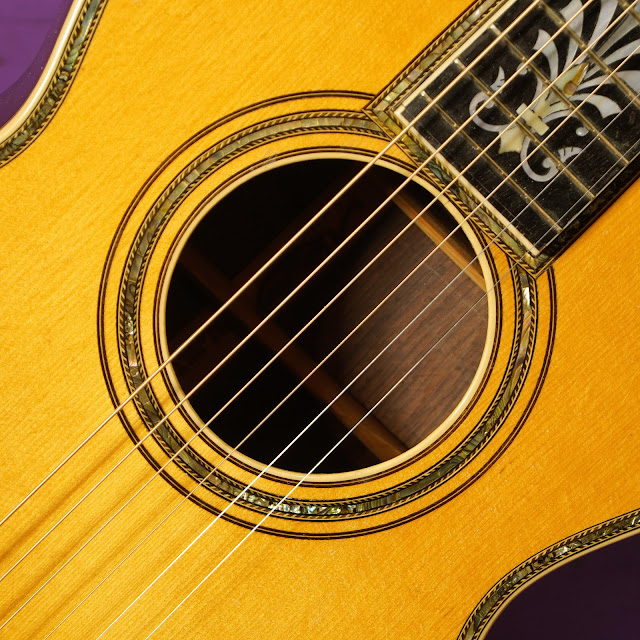1920s Larson-made Maurer 595 000-size Guitar
Oh my! That's what I thought when I popped the case on this one. It's not every day a presentation-grade Larson Brothers creation walks in the shop. This one was here for surgery, too, but it wasn't overly-complicated work, much to my relief.
For those not in the know, Larson Brothers guitars (out of Chicago) have become hot commodities. They're traded in the same circles you'd find '30s Martins in. As far as I know, none of the Larson builds bear the name of the actual makers and instead are found under various brands like "Prairie State" and "Stahl" and "Euphonon" among others. I've worked on many Larson mandolins found under the Mayflower, Stahl, and Ditson brands, for example.
This guy has Martin Style 45 appointments and then some. The fretboard pearl inlay is intense, every edge is bound, the top is entirely fit with pearl trim, and quality everything is used throughout.
It has interesting bracing, too. It's x-braced like a period Martin but the braces are a bit more tapered and less super-scalloped. Each brace on this guitar is also a laminated sandwich and that adds a lot of stiffness and strength but minimal weight increase. That's read as: good. The tops on these are built "under tension" in a lightly-domed shape and that also helps stiffen the top so that it can be thinned-up without its structure suffering. In fact... this is the only old, lightly-built, boutique-level guitar I've strung-up and then not watched the top "belly" literally before my eyes as tension was added. It's remarkable, to be honest.
The body has interesting specs as well. It's a roughly 000-size instrument but the body depth is fairly thin. It also plays more like an OM model because it has a long (especially for the period) 25 1/2" scale length. I backed-off the string gauges to 11s because of the light build and long scale, but I wouldn't be surprised if the guitar could take 12s at concert pitch with no problem.
Tonewise, it's pretty glorious -- full and rich and velvety in that Martin way. Because of that, the mids are slightly scooped (it goes along with the design), but it has piano-like lows, a ton of sustain, and a really responsive upper-mids and treble presence. It'll do flatpicking or fingerpicking excellently and it doesn't mind being leaned-upon. I find this a little disconcerting because I've mostly worked on ladder-braced old Larson guitars in the past (and only had x-braced ones in for a few minutes at a time besides) and they're the polar opposite in tone and response -- instruments mostly suited to fingerpicking and with a clean, sustained, almost delicate balance that doesn't like a lot of heavy-handed picking.
This guy arrived with a 3" bolt installed through its heel which, once removed, made the neck reset work fairly easy as the neck popped right off after I separated the fretboard extension from the top. The rest of my work was glorified-setup-side and an install of some new (repro) tuners.
Yes, the top is solid spruce and has no cracks. Yes, the back and sides are solid Brazilian rosewood... and only a couple of thin, tight hairline cracks in the sides.
Repairs included: a neck reset, fret level/dress, heel touchup, new (repro) tuners install/headstock minor repairs, mild saddle-slot recut and new, compensated bone saddle install, cleaning, and setup.
Top wood: solid spruce
Back & sides wood: solid Brazilian rosewood
Bracing type: x, laminated bracing, small maple bridge plate
Bridge: ebony
Fretboard: ebony
Neck wood: mahogany, 2-piece
Action height at 12th fret: 3/32” bass 1/16” treble (fast, spot-on)
String gauges: 52w-11 custom lights
Neck shape: medium-full C
Board radius: ~12"
Truss rod: non-adjustable
Neck relief: straight
Fret style: medium/narrow
Scale length: 25 1/2"
Nut width: 1 7/8"
Body width: 15"
Body depth: 3 1/4"
Weight: 3 lbs 8 oz
Condition notes: there's what appears to be epoxy spill from an old bridge reglue (sigh!) on the top around the bridge. There are minor scratches, nicks, and dings throughout. I wouldn't be surprised if the whole instrument had one very thin coat of overspray, too. Most fittings appear to be original but the tuners and saddle are new. It has a couple of repaired hairline cracks in the sides. There's a patched area at the back of the heel where a bolt had been installed in the past. The heel also has an old split about halfway up that was repaired ages ago and is sturdy.


























Comments
Chris Vallillo, Orphan Instruments